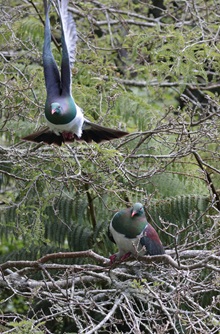The annual citizen’s science project took place over 10 days between 18-27 September and a total of 21,509 kererū were counted around Aotearoa. This is well up on last year’s count of 14,248.
In Wellington, 5,619 of the quirky birds (or 26 percent of the total national count) were seen – the highest figure from any region – with runners up Auckland spying 3,580 kererū and Otago 3,475.
Kererū are protected birds that only live in New Zealand, and Great Kererū Count coordinator Tony Stoddard, of Kererū Discovery, says there’s a lot to admire about these special birds.
“Whether you love their classic white singlets, their whooping wing-beats, or their awesome aerial acrobatics, kererū are especially unique to us.”
Tony says this year’s amazing public effort will enhance the scientific understanding of how kererū are doing across the country.
“The Great Kererū Count is about New Zealanders working together to create a statistically significant data set on kererū so we can understand what we can do to help them thrive.
“There were loads of incredible stories shared about experiences with kererū during the 10-day count. It is inspirational and makes me feel incredibly hopeful for a future where kererū numbers are as abundant as they once were.”
This year was the seventh year that this citizen science project has gone ahead. Tony says the project’s aim is to have eight years of data which will provide a good understanding of population trends.

The Great Kererū Count is a collaborative project lead by Urban Wildlife Trust and Kererū Discovery together with partners Wellington City Council, Dunedin City Council/City Sanctuary, Nelson City Council and Victoria University of Wellington.
Wellington City Council’s Open Space and Parks Manager Myfanwy Emeny says the organisation is proud to be a key partner and funder of the project.
“This is one of the many initiatives that we can support which contributes to improving biodiversity for our natural environment, and for the benefit of Wellingtonians.”
Urban Ecology Manager Daniela Biaggio says as well as enhancing our knowledge of these great birds, the Great Kererū Count provides an opportunity for Wellingtonians to connect with nature and explore their surroundings.
Kererū numbers today remain much lower than the flocks reported from 50-100 years ago.
The main threat to kererū is predation by introduced mammals, particularly feral cats, possums, stoats, and rats. Other threats include collisions with man-made objects such as fast-moving vehicles, overhead power and telephone wires, fences and windows, and illegal hunting.
Since 2011, Pōneke has seen a rise in native birds making the city home, with tūī, fantail, kākā, kākāriki, North Island saddleback and kererū numbers increasing significantly.
This would not be possible for some vulnerable native bird species without the mammalian predator control work happening in Wellington’s parks and reserves and backyards. In addition several restoration planning community groups have planted thousands of trees over the years providing a food source for the birds.
As well as Council’s contracted pest control work, there are many passionate and hardworking community groups making a difference for the city.
Some community trapping highlights from this year include:
- Cross Country Vehicle Club removing 100 mustelids from Te Kopahou
- Mount Victoria Vermin Trappers recently trapping their 2000th rat
- Tanera Gully Restoration Group’s rat-proofing of Epuni Street’s community compost station
- Trap network expansion in Mt Albert, TawaTawa reserve and Churton Park
- Deployment of a continuous trapline stretching from Red Rocks to Miramar along the South Coast.
Social Media
Kererū Discovery Facebook:
https://facebook.com/kererudiscovery
Kererū Discovery Twitter:
https://twitter.com/KereruDiscovery
#GKC2020
@kererudiscovery